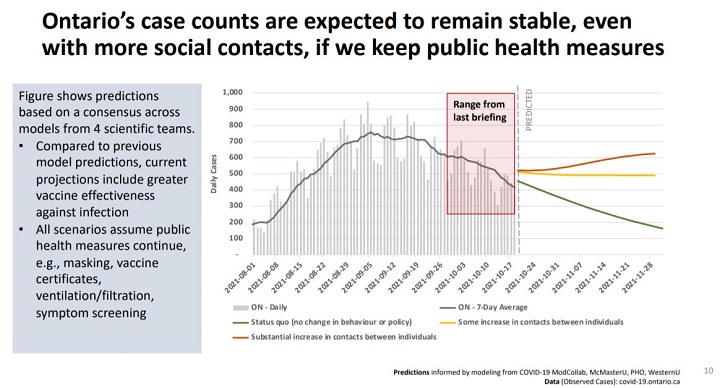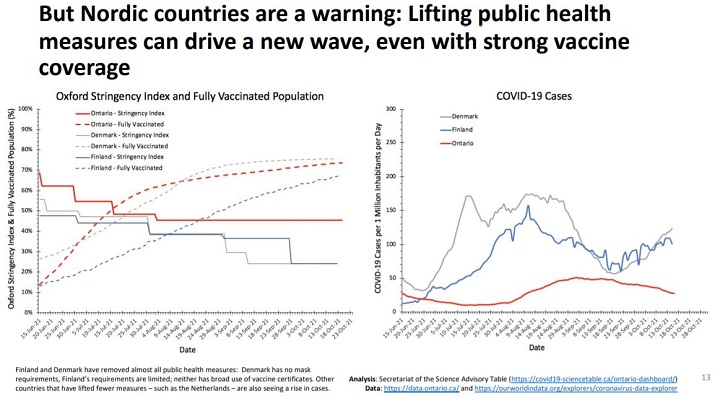Recently released provincial modelling suggests that Ontario’s COVID-19 case counts will remain stable, even with more social contacts, if some public health measures remain in place.

Ontario’s COVID-19 Science Advisory Table released their updated projections on Friday. The team cited favourable numbers due to high vaccination rates in the province and continued public health measures but it cautioned the need to keep some measures in place and focus on vaccinating young children when they are eligible.
In three scenarios (worst to best), case counts are projected to remain under 700 by the end of November in the worst case with the best case scenario looking at around 200 new cases by the end of the month.
The scenarios were based on a substantial increase in contact between people, some increased contact and remaining status quo with no change in behaviour or policy. All models assume public health measures such as masking, vaccine certificates, ventilation and symptom screening continue.
Ontario has seen declining case counts daily over the last month with the seven-day average going to around 400 from 700. Active cases have also dropped.
However, most but not all local public health units are seeing a decline in cases. Some PHUs seeing a 14-day increase in new cases include Southwestern, Sudbury, KFLA, Simcoe Muskoka, Hastings & Prince Edward County, Timiskaming, Renfrew, and Grey Bruce. The rest of the local public health units are seeing 14-day decreases, the science table said.
In addition, hospitalizations and those in intensive care units have remained stable over the last several weeks. It is also expected that these will remain stable until the end of November in all scenarios.
Testing and test positivity in the province has remained flat, the science table noted.

Get weekly health news
The science table cautioned that lifting public health measures can drive a new wave — even with strong vaccine coverage — pointing at what has happened in some Nordic countries such as Denmark and Finland who opened up too much and too quickly.
These jurisdictions removed nearly all public health measures including masking, Ontario’s health ministry added shortly after the slides on modelling were released.
Dr. Peter Juni, the scientific director for the science table, spoke to Global News about the comparison of Ontario to a country such as Denmark in the modelling presentation.
“Denmark has a lot of advantages over Ontario, structurally speaking, with a lot less problems like socio-economic status, a lot less problems with living situations of people, but they lifted nearly all restrictions and guess what? Case numbers are exploding again. We want to avoid that.” Juni said.
Child and youth vaccination against COVID-19
The science table also said moving into the colder months, vaccinating children will be key, once it is approved by Health Canada.
Children aged 11 and younger are not yet eligible to be vaccinated and remain unprotected.
“If we adopt smart, tailored strategies – like working with children, parents, schools, and communities – we can set the course for a strong immunization program in children when the vaccine is approved in younger age groups,” the science table noted in its report.
The science table also said that vaccination continues to be highly effective. It said unvaccinated people have a seven-fold higher risk of symptomatic COVID-19 disease, a 17-fold higher risk of being in the hospital and a 23-fold higher risk of being in the ICU compared to people who are fully vaccinated.
“We’re not seeing much waning immunity after vaccination in the general population — but of course, we’re watching,” the science table said.
The latest provincial figures show that in Ontario, over 87 per cent of people aged 12-plus have received at least one COVID-19 vaccine dose and 83.6 per cent are fully vaccinated.
‘We’re in really good shape right now,’ advisory table’s scientific director says
Dr. Peter Juni, the scientific director for Ontario’s COVID-19 Science Advisory Table and a professor of medicine and epidemiology at the University of Toronto, said the province is in good shape right now.
Juni pointed to the period after the Thanksgiving holiday weekend and lifting restrictions on major sports and concert venues that week-over-week, and looking at the same day of the week, case counts have remained stagnant.
He said changes to policy such as lifting capacity limits need to be looked at after a two- to three-week period to determine its impact.
“We can probably afford a little bit of mobility and contacts … as long we stick to masking and as long as we still to vaccine certificates,” Juni said, referencing how the provincial government is lifting capacity limits on restaurants, bars and gyms as of Monday.
He also said when looking at a broad range of dropping the rest of public health measures that the spring of 2022 would be a realistic timeframe due to weather, although that time is not set in stone.
“Spring 2022 is probably a realistic timeframe,” Juni said.
“The moment we start to move outdoors again and have experienced our children five to 11 could get vaccinated, that’s the moment where we might be able to lift more restrictions or nearly all restrictions if we don’t have a challenge with a new variant coming — that’s a mighty if, but fingers crossed that Delta is the last curveball we’re experiencing.
“With winter coming we can’t afford that much and these places like Denmark, Finland, the U.K. etc., they will continue to struggle and they will need to do something about that again.”
— With files from Matthew Bingley














Comments